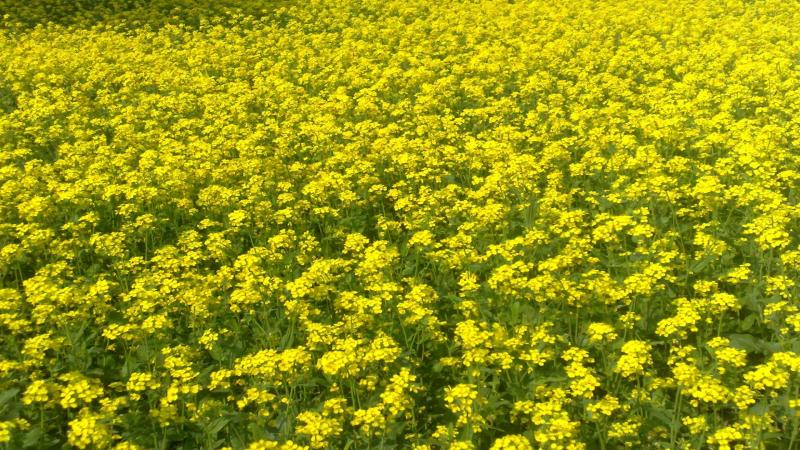
India is the third-largest producer of mustard and rapeseed, with an annual production of 8.5 million tonnes in 2018. About 70% of the crop is cultivated in five states — Rajasthan, Uttar Pradesh, Madhya Pradesh, Haryana and Gujarat. The moist and foggy weather in winter is conducive for fungi to infect the mustard crop, which needs about 90 to 145 days to be ready for harvest. One such fungus is Alternaria brassicae, which causes the blight disease in mustard. The disease results in black spots on the leaves, stems or pods, and the seeds in the pod become smaller, shrivelled and discoloured, losing their market value. In India, blight leads to about 47% reduction in the seed yield, and farmers incur a significant loss.
Interestingly, it has been observed that in a field with chickpeas and mustard crops, the pathogen Alternaria brassicae attacks only mustard sparing the chickpea. This observation led scientists from the National Institute of Plant Genome Research, New Delhi, and Assam Agricultural University, Jorhat, to closely understand the tricky defence used by chickpea plants against blight. In a recent study, published in the journal Molecular Plant-Microbe Interactions, the researchers have described how chickpea evades blight infection, thus paving the way to develop a blight-tolerant mustard variety.
Previously developed blight-resistant varieties of mustard are not successful because the wild relatives of the crop, used in breeding, are all prone to Alternaria attack. Farmers are advised to rotate their crops by growing plants resistant to Alternaria infections just after a season of growing crops that are highly prone to them. As the blight pathogen spreads through wind, seeds and debris of infected plants, this strategy overcomes the residual effects of fungal infection extending over seasons.
However, when this pathogen enters some plants like chickpea, it fails to grow and proliferate. The plant's robust resistance strategy, known as non-host resistance (NHR), serves as a promising solution to prevent blight in mustard crops. Generally, the non-host resistance is multi-layered consisting of strategies that defend the plant before entry (pre-invasive) and after entry (post-invasive) of the pathogen.
“Our team recognised that chickpeas have the arsenal to ward off the Alternaria fungi while the susceptible mustard, cultivated adjacent to it, could not,” says Dr Muthappa Senthil-Kumar, the corresponding author of the study. He is a scientist at NIPGR, New Delhi.
The researchers used fluorescence microscopy to observe the development of the fungal infection in mustard and chickpea plants over a period of seven days. In mustard, within 24 hours of the infection setting in, the fungi entered the seed through the surface pores on the leaves and stems. On the contrary, in chickpeas, the infection occurred only after 48 hours of exposure to the fungi. After 72 hours, the spread of the fungus was suppressed. The infection severity in mustard was evaluated by the presence of dead cells, which appeared as spots on leaves and stem. In chickpea, no such symptoms were observed, indicating its resistance strategy towards Alternaria.
It is known that in chickpeas, the plants prevent the quick penetration or invasion of the fungi by closing the pores on the leaves, called stomata, or forming excessive wax on the plant surface. The researchers found that the genes associated with stomatal closure, thickening of the cell wall and cuticular wax formation were active at the time of infection in chickpeas. They also observed enhanced expression of genes associated with the production of a plant hormone called abscisic acid.
"There is a correlation between abscisic acid production and stomatal closure. This is reflected in our transcriptomic data,” says Dr Senthil-Kumar.
Besides, the chickpea plants produced reactive oxygen species (ROS), which initiate cell death after the pathogen enters. The localised cell death at the infection site is the reason behind the suppression of blight symptoms during the later stages of the infection.
Currently, the researchers are trying to screen candidate genes that can impart resistance to Alternaria and develop chickpea plants in which the pathogen-resistant genes are silenced. "The gene-silenced plants will further be evaluated for the overall plant performance and its response towards Alternaria by infecting them with fungi,” says Dr Senthil-Kumar. If successful, the researchers plan to transfer these selected genes to the model plant thale cress (Arabidopsis thaliana).
“Once the method is established in the model, we will develop transgenic mustard plants by adopting CRISPR-based gene editing or conventional transgenics approach,” he signs off.
This article has been run past the researchers, whose work is covered, to ensure accuracy.





